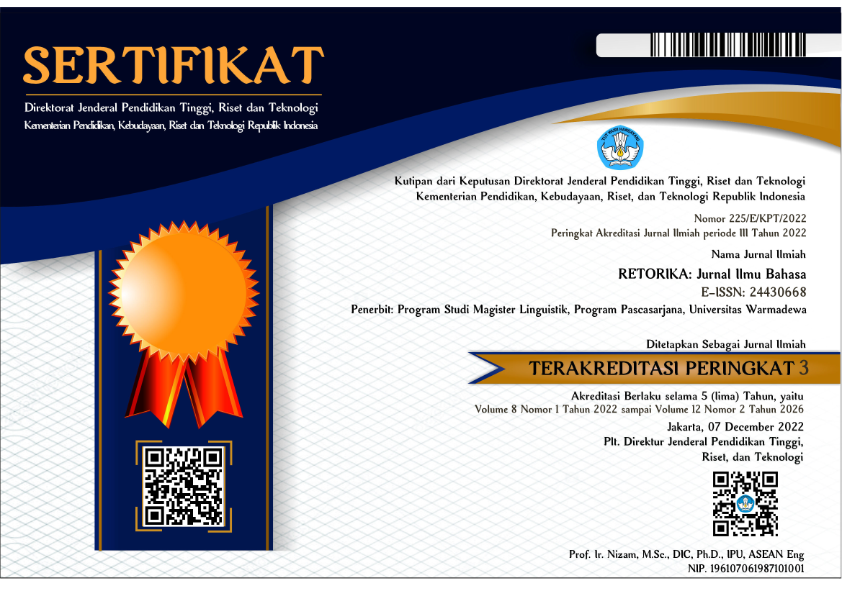Nautical Eco-Lexicon of Lamaholot Language of Bahinga Village
Abstract
This study examines the treasury of eco-lexicon in order to reveal the level of society's knowledge on the diversity of lexicon, the metaphorical expressions and the mythology of the nautical matter of the language. To achieve these objectives, I made use of quantitative-qualitative research method. I collected the data by using observation, interview and questionnaire methods. The results of the study show there are 87 nautical nominal laxicons in the form of base, 24 lexicons in the form of phrase, and 16 lexicons in the form of verb "to catch"; there are 18 lexicons connecting to the expression of metaphors and myths of nautical matter that are dilated by the three dimensions of social praxis; and the level of society’s knowledge about the lexicon, metaphorical expressions, and myth of nautical matter of Lamaholot language in Bahinga Village is among others: the group of elderly have an average knowledge of 76% and above (really know), adults have an average knowledge of 51% 75% (know), and adolescents have an average knowledge of 26% -50% (less know).References
Barreira da Silva Rocha, A. (2018). Social outcomes due to the interplay between language competition and ideology struggle. Physica A: Statistical Mechanics and Its Applications, 492, 1340–1351.
Chen, S. (2016). Language and ecology: A content analysis of ecolinguistics as an emerging research field. Ampersand, 3, 108–116.
Cowley, S. J. (2014). Bio-ecology and language: A necessary unity. Language Sciences, 41, 60–70.
Do Couto, H. H. (2014). Ecological approaches in linguistics: A historical overview. Language Sciences, 41, 122–128.
Erawati. (2013). Erosi Leksikon Bidang Persawahan di Bali: Kajian Ekolinguistik (Tesis). Denpasar: Universitas Udayana.
Feng, R., & Fan, A. (2012). A Brief Analysis on the Lettered Words in Chinese--From the Perspective of Ecolinguistics. IERI Procedia, 2, 194–199.
Fill, A & Mühlhäusler, P. (2004). The Ecolinguistics: Language Reader, Ecology, and Environment. Language and Communication, 24(4), 183–205.
Finke, P. (2014). The ecology of science and its consequences for the ecology of language. Language Sciences, 41, 71–82.
Ghafar Samar, R., & Bhatia, T. K. (2017). Predictability of language death: Structural compatibility and language contact. Language Sciences, 62, 52–65.
Gontier, N. (2017). What are the levels and mechanisms/processes of language evolution? Language Sciences, 63, 12–43.
Katamba, F. (1993). Morphology. London: The Macmillan Press.
Kraisame, S. (2018). Language endangerment and community empowerment: Experience form community training in the Moken language documentation and preservation project. Kasetsart Journal of Social Sciences, 39(2), 244–253.
Kridalaksana. (1984). Kamus Linguistik. Jakarta: Gramedia.
Mbete, A. M. (2002). Ungkapan-Ungkapan Dalam Bahasa Lio dan Fungsinya Dalam Melestarikan Lingkungan. Denpasar: Universitas Udayana.
Mühlhäusler, P. (2006). Environment and Language. Encyclopedia of Language & Linguistics, 203–207.
Nash, J., & Orman, J. (2013). Things people speak?: A response to Orman’s “Linguistic diversity and language loss: A view from integrational linguistics†with rejoinder. Language Sciences, 41(PB), 222–226.
Pérez, I. C. (2015). Indigenous Languages, Identity and Legal Framework in Latin America: An Ecolinguistic Approach. Procedia - Social and Behavioral Sciences, 212, 111–116.
Ramlan, M. (1985). Morfologi: Suatu Tinjauan Deskriptif. Yogyakarta: Karyono.
Ramlan, M. (2005). Ilmu Bahasa Indonesia. Yogyakarta: CV Karyono.
Roberts, G., & Fedzechkina, M. (2018). Social biases modulate the loss of redundant forms in the cultural evolution of language. Cognition, 171(July 2017), 194–201.
Sukhrani, D. (2010). Leksikon Nomina Bahasa Gayo Dalam Lingkungan Kedanauan Lut Tawar: Kajian Ekolinguistik (Tesis). Medan: Universitas Sumatra Utara.
Tangkas, D. (2013). Khazanah Verbal Kepadian Komunitas Tutut Bahasa Kodi, Sumba Barat Daya: Kajian Ekolinguistik (Tesis). Denpasar: Universitas Udayana.
Copyright (c) 2018 RETORIKA: Jurnal Ilmu Bahasa

This work is licensed under a Creative Commons Attribution-ShareAlike 4.0 International License.
This journal provides immediate open access to its content on the principle that making research freely available to the public supports a greater global exchange of knowledge.
All articles published Open Access will be immediately and permanently free for everyone to read and download. We are continuously working with our author communities to select the best choice of license options, currently being defined for this journal as follows: Creative Commons-Non Ceomercial-Attribution-ShareAlike (CC BY-NC-SA)
 Abstract viewed = 179 times
Abstract viewed = 179 times
 PDF downloaded = 141 times
PDF downloaded = 141 times

2.png)














